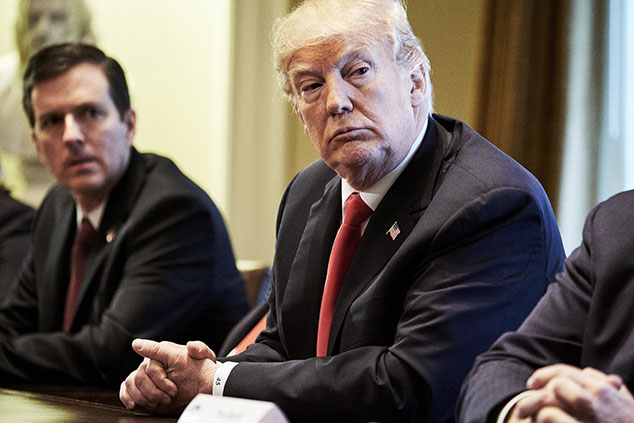
Back in the financial crisis of 2008, comparisons with the Great Depression were rife.
Those comparisons made sense, because we were basically facing the same problem as we did back then. A hugely overstretched financial system collided with rampant overcapacity and sent us spinning into an epic deflationary bust.
But part of the 1930s parallel never materialised – the spiral of beggar-thy-neighbour protectionism. We thought we had avoided tariffs by using “currency wars” instead.
Each major country took it in turns to weaken its own currency, which was essentially a zero-sum game and almost civilised by comparison.
However, we might have been a bit too early to breathe a sigh of relief.
The national security risk posed by Canadian steel isn’t obvious
Yesterday, US president Donald Trump said that from next week, he wants to impose big tariffs of 25% on steel and 10% on aluminium imports into the US.
Steelmakers loved it and their stocks rallied sharply. The rest of the market wasn’t so keen. The Dow Jones and the S&P 500 had another uncomfortable day yesterday, falling by 1.7% and 1.3% respectively. Not much in the grand scheme of things, but a big change from the ever-rising market we saw last year.
Trump is using national security as justification for the move (under international trade law, according to the FT, countries are able to impose trade restrictions “in times of war”).
Fundamentally, this is about China producing too much metal and “dumping” it on the world market at cheap prices. Because China’s economy isn’t run on a free market basis, Chinese producers are in effect, subsidised by the state. That gives them an unfair advantage over producers in other countries, or so the argument goes.
The thing is, though, it’s not just China who sends steel and aluminium to the US. Indeed, Canada is the biggest trading partner on that score, and the European Union isn’t far behind.
So we can expect retaliation on top of the already somewhat grumpy responses from the EU and Canada’s representatives.
But what’s the potential fallout – how costly could it be?
The US currently imports around a third of its steel. But overall, notes Capital Economics, steel and aluminium account for just 2% of imports. So the effect on prices shouldn’t be huge.
However, “the knock-on impact could be greater. Domestic US steel prices have already risen by 20% since the start of the year in anticipation of protectionist measures.”
That’s bad news. Because while steelmakers might like it, the companies who use steel won’t. It’ll mean higher costs for them, and as a result, higher charges for their customers.
And the sectors involved are a lot larger than the steel and aluminium production industries. We’re talking about car manufacturing, construction, the energy industry – a wide swathe of American businesses will feel the hit from this.
“Ironically, the tariffs actually raise the incentives for… manufacturers to offshore production and to avoid the tariffs.” But construction firms can’t do that, which means they’ll need to pass the costs onto consumers.
In other words, overall this is inflationary. And it’s not just about rising prices. There isn’t much slack in the labour market right now (US weekly claims for jobless benefits fell to their lowest level since 1969 last week).
If the US now wants to ramp up domestic steel production then, says Capital Economics, it “could worsen labour and material shortages and push prices even higher,” as employers chase scarce skilled staff.
Who would be stupid enough to start a trade war? Umm…
This has been tried before. George Bush imposed short-lived tariffs in 2002 after the World Trade Organisation said they were illegal, and other countries promised to boycott various key American goods.
Already the EU, via its trade commissioner Cecilia Malmstrom, is saying that it will “have no choice but to respond”, notes the FT. The risk is that because Trump has gone for the “national security” loophole, it’ll be open season.
As the FT puts it: “That move would end a decades-old ceasefire on using a loophole in global trading rules intended to be employed only in times of war or other national emergencies.”
In other words, you can tell the WTO to get stuffed and do what you like. As Malmstrom says: “We risk seeing a dangerous domino effect from this.”
Part of the problem is that if the US imposes tariffs, then other countries will start dumping on Europe, for example. Hence Europe then has to impose its own tariffs to avoid that happening.
Will we spiral into a trade war? Trump is even more pig-headed than Bush was, so it can’t be ruled out. And most of his advisers (it seems) were not keen on this particular course of action, which didn’t stop him from taking it.
We’ll just have to wait and see, but I think the bigger point to take from this is that the forces of inflation are picking up everywhere. We’ve been out of that mode of thinking for a long time, so it’s hard to shake off the deflationary psychology.
But the assumptions we used to make – like “who would be stupid enough to ignite a trade war?” – cannot be relied upon anymore. In this week’s issue of MoneyWeek magazine I talk about the risks to the bond market and what it all means for your money – this is just one more piece in the puzzle.
If you don’t already subscribe to MoneyWeek, now would definitely be a good time to start.